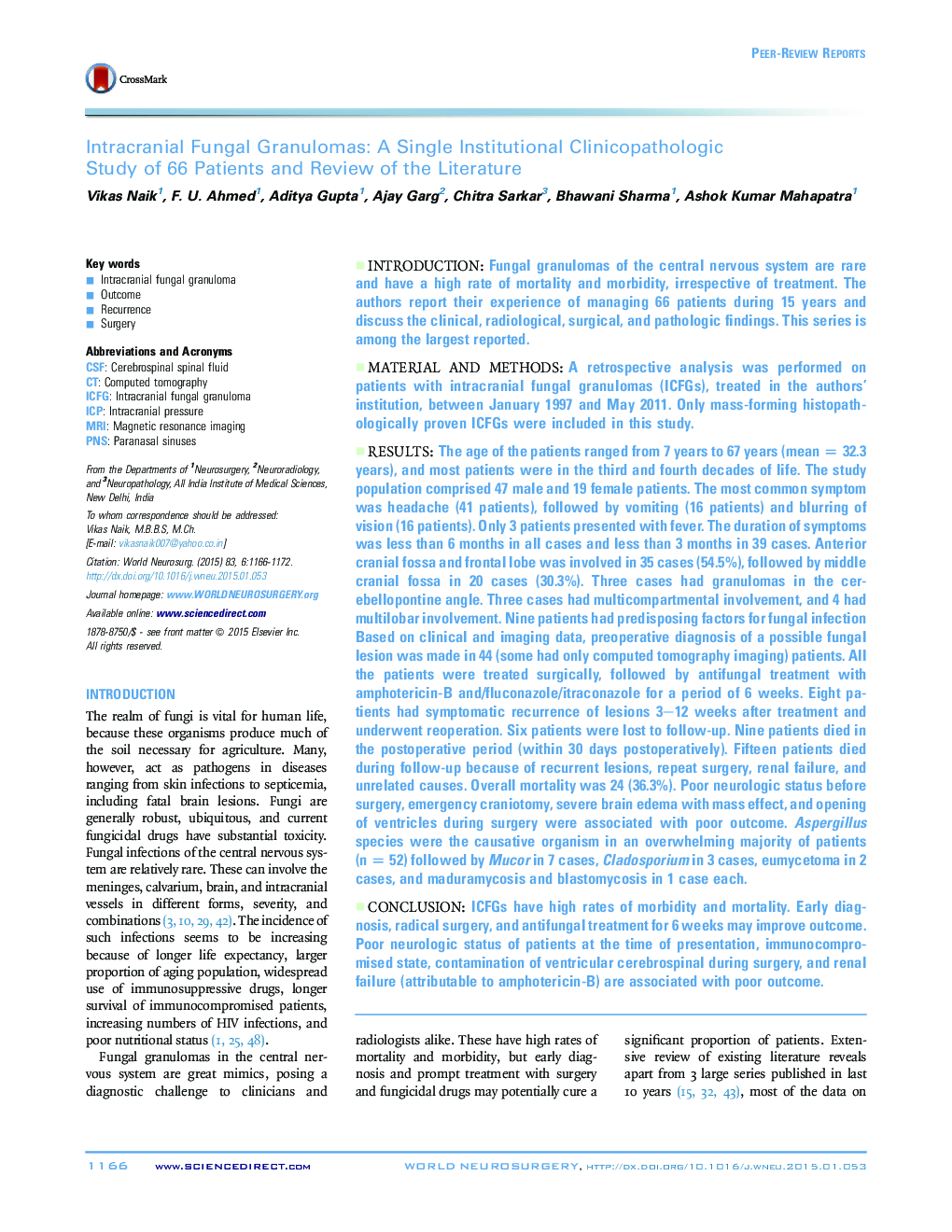| کد مقاله | کد نشریه | سال انتشار | مقاله انگلیسی | نسخه تمام متن |
|---|---|---|---|---|
| 6045310 | 1190906 | 2015 | 7 صفحه PDF | دانلود رایگان |
IntroductionFungal granulomas of the central nervous system are rare and have a high rate of mortality and morbidity, irrespective of treatment. The authors report their experience of managing 66 patients during 15 years and discuss the clinical, radiological, surgical, and pathologic findings. This series is among the largest reported.Material and MethodsA retrospective analysis was performed on patients with intracranial fungal granulomas (ICFGs), treated in the authors' institution, between January 1997 and May 2011. Only mass-forming histopathologically proven ICFGs were included in this study.ResultsThe age of the patients ranged from 7 years to 67 years (mean = 32.3 years), and most patients were in the third and fourth decades of life. The study population comprised 47 male and 19 female patients. The most common symptom was headache (41 patients), followed by vomiting (16 patients) and blurring of vision (16 patients). Only 3 patients presented with fever. The duration of symptoms was less than 6 months in all cases and less than 3 months in 39 cases. Anterior cranial fossa and frontal lobe was involved in 35 cases (54.5%), followed by middle cranial fossa in 20 cases (30.3%). Three cases had granulomas in the cerebellopontine angle. Three cases had multicompartmental involvement, and 4 had multilobar involvement. Nine patients had predisposing factors for fungal infection Based on clinical and imaging data, preoperative diagnosis of a possible fungal lesion was made in 44 (some had only computed tomography imaging) patients. All the patients were treated surgically, followed by antifungal treatment with amphotericin-B and/fluconazole/itraconazole for a period of 6 weeks. Eight patients had symptomatic recurrence of lesions 3-12 weeks after treatment and underwent reoperation. Six patients were lost to follow-up. Nine patients died in the postoperative period (within 30 days postoperatively). Fifteen patients died during follow-up because of recurrent lesions, repeat surgery, renal failure, and unrelated causes. Overall mortality was 24 (36.3%). Poor neurologic status before surgery, emergency craniotomy, severe brain edema with mass effect, and opening of ventricles during surgery were associated with poor outcome. Aspergillus species were the causative organism in an overwhelming majority of patients (n = 52) followed by Mucor in 7 cases, Cladosporium in 3 cases, eumycetoma in 2 cases, and maduramycosis and blastomycosis in 1 case each.ConclusionICFGs have high rates of morbidity and mortality. Early diagnosis, radical surgery, and antifungal treatment for 6 weeks may improve outcome. Poor neurologic status of patients at the time of presentation, immunocompromised state, contamination of ventricular cerebrospinal during surgery, and renal failure (attributable to amphotericin-B) are associated with poor outcome.
Journal: World Neurosurgery - Volume 83, Issue 6, June 2015, Pages 1166-1172
